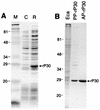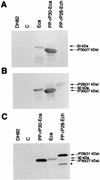Cloning and characterization of multigenes encoding the immunodominant 30-kilodalton major outer membrane proteins of Ehrlichia canis and application of the recombinant protein for serodiagnosis
- PMID: 9705412
- PMCID: PMC105182
- DOI: 10.1128/JCM.36.9.2671-2680.1998
Cloning and characterization of multigenes encoding the immunodominant 30-kilodalton major outer membrane proteins of Ehrlichia canis and application of the recombinant protein for serodiagnosis
Abstract
A 30-kDa major outer membrane protein of Ehrlichia canis, the agent of canine ehrlichiosis, is the major antigen recognized by both naturally and experimentally infected dog sera. The protein cross-reacts with a serum against a recombinant 28-kDa protein (rP28), one of the outer membrane proteins of a gene (omp-1) family of Ehrlichia chaffeensis. Two DNA fragments of E. canis were amplified by PCR with two primer pairs based on the sequences of E. chaffeensis omp-1 genes, cloned, and sequenced. Each fragment contained a partial 30-kDa protein gene of E. canis. Genomic Southern blot analysis with the partial gene probes revealed the presence of multiple copies of these genes in the E. canis genome. Three copies of the entire gene (p30, p30-1, and p30a) were cloned and sequenced from the E. canis genomic DNA. The open reading frames of the two copies (p30 and p30-1) were tandemly arranged with an intergenic space. The three copies were similar but not identical and contained a semivariable region and three hypervariable regions in the protein molecules. The following genes homologous to three E. canis 30-kDa protein genes and the E. chaffeensis omp-1 family were identified in the closely related rickettsiae: wsp from Wolbachia sp. , p44 from the agent of human granulocytic ehrlichiosis, msp-2 and msp-4 from Anaplasma marginale, and map-1 from Cowdria ruminantium. Phylogenetic analysis among the three E. canis 30-kDa proteins and the major surface proteins of the rickettsiae revealed that these proteins are divided into four clusters and the two E. canis 30-kDa proteins are closely related but that the third 30-kDa protein is not. The p30 gene was expressed as a fusion protein, and the antibody to the recombinant protein (rP30) was raised in a mouse. The antibody reacted with rP30 and a 30-kDa protein of purified E. canis. Twenty-nine indirect fluorescent antibody (IFA)-positive dog plasma specimens strongly recognized the rP30 of E. canis. To evaluate whether the rP30 is a suitable antigen for serodiagnosis of canine ehrlichiosis, the immunoreactions between rP30 and the whole purified E. canis antigen were compared in the dot immunoblot assay. Dot reactions of both antigens with IFA-positive dog plasma specimens were clearly distinguishable by the naked eye from those with IFA-negative plasma specimens. By densitometry with a total of 42 IFA-positive and -negative plasma specimens, both antigens produced results similar in sensitivity and specificity. These findings suggest that the rP30 antigen provides a simple, consistent, and rapid serodiagnosis for canine ehrlichiosis. Cloning of multigenes encoding the 30-kDa major outer membrane proteins of E. canis will greatly facilitate understanding pathogenesis and immunologic study of canine ehrlichosis and provide a useful tool for phylogenetic analysis.
Figures









Similar articles
-
Immunodominant major outer membrane proteins of Ehrlichia chaffeensis are encoded by a polymorphic multigene family.Infect Immun. 1998 Jan;66(1):132-9. doi: 10.1128/IAI.66.1.132-139.1998. Infect Immun. 1998. PMID: 9423849 Free PMC article.
-
Western and dot blotting analyses of Ehrlichia chaffeensis indirect fluorescent-antibody assay-positive and -negative human sera by using native and recombinant E. chaffeensis and E. canis antigens.J Clin Microbiol. 1999 Dec;37(12):3888-95. doi: 10.1128/JCM.37.12.3888-3895.1999. J Clin Microbiol. 1999. PMID: 10565902 Free PMC article.
-
Molecular cloning of the gene for a conserved major immunoreactive 28-kilodalton protein of Ehrlichia canis: a potential serodiagnostic antigen.Clin Diagn Lab Immunol. 1999 May;6(3):392-9. doi: 10.1128/CDLI.6.3.392-399.1999. Clin Diagn Lab Immunol. 1999. PMID: 10225842 Free PMC article.
-
Restriction and expansion of Ehrlichia strain diversity.Vet Parasitol. 2007 Feb 28;143(3-4):337-46. doi: 10.1016/j.vetpar.2006.08.027. Epub 2006 Sep 22. Vet Parasitol. 2007. PMID: 16996215 Review.
-
Significance of serological testing for ehrlichial diseases in dogs with special emphasis on the diagnosis of canine monocytic ehrlichiosis caused by Ehrlichia canis.Vet Parasitol. 2001 Feb;95(1):1-15. doi: 10.1016/s0304-4017(00)00407-6. Vet Parasitol. 2001. PMID: 11163693 Review.
Cited by
-
Proteomic profiling of the outer membrane fraction of the obligate intracellular bacterial pathogen Ehrlichia ruminantium.PLoS One. 2015 Feb 24;10(2):e0116758. doi: 10.1371/journal.pone.0116758. eCollection 2015. PLoS One. 2015. PMID: 25710494 Free PMC article.
-
The genome of the heartwater agent Ehrlichia ruminantium contains multiple tandem repeats of actively variable copy number.Proc Natl Acad Sci U S A. 2005 Jan 18;102(3):838-43. doi: 10.1073/pnas.0406633102. Epub 2005 Jan 6. Proc Natl Acad Sci U S A. 2005. PMID: 15637156 Free PMC article.
-
Culture and phenotypic characterization of a Wolbachia pipientis isolate.J Clin Microbiol. 2003 Dec;41(12):5434-41. doi: 10.1128/JCM.41.12.5434-5441.2003. J Clin Microbiol. 2003. PMID: 14662922 Free PMC article.
-
Recombinant Ehrlichia P29 protein induces a protective immune response in a mouse model of ehrlichiosis.Vaccine. 2013 Dec 5;31(50):5960-7. doi: 10.1016/j.vaccine.2013.10.036. Epub 2013 Oct 19. Vaccine. 2013. PMID: 24144475 Free PMC article.
-
Cloning of the major outer membrane protein expression locus in Anaplasma platys and seroreactivity of a species-specific antigen.J Bacteriol. 2011 Jun;193(12):2924-30. doi: 10.1128/JB.00082-11. Epub 2011 Apr 15. J Bacteriol. 2011. PMID: 21498646 Free PMC article.
References
-
- Buhles W C, Huxsoll D L, Ristic M. Tropical canine pancytopenia: clinical, haematologic, and serologic, and serologic response of dogs to Ehrlichia canis infection, tetracycline therapy, and challenge inoculation. J Infect Dis. 1974;130:358–367. - PubMed
-
- Cadman H F, Kelly P J, Matthewman L A, Zhou R, Mason P R. Comparison of the dot-blot enzyme linked immunoassay with immunofluorescence for detecting antibodies to Ehrlichia canis. Vet Rec. 1994;135:362. - PubMed
-
- Codner E C, Farris-Smith L L. Characterization of the subclinical phase of ehrlichiosis in dogs. J Am Vet Med Assoc. 1986;189:47–50. - PubMed
Publication types
MeSH terms
Substances
Associated data
- Actions
- Actions
- Actions
Grants and funding
LinkOut - more resources
Full Text Sources
Other Literature Sources
Molecular Biology Databases
Research Materials

